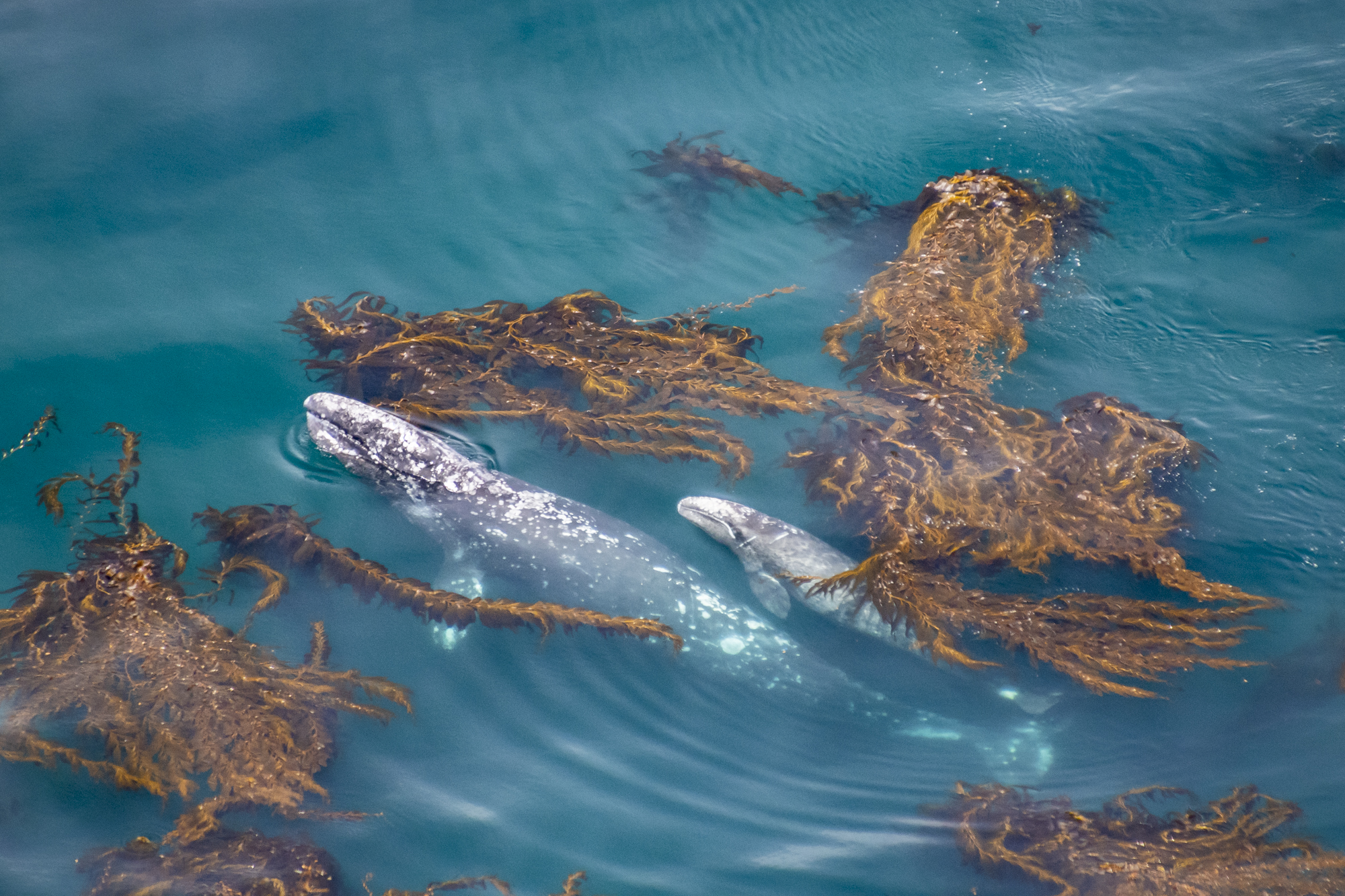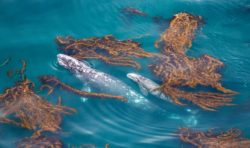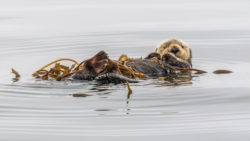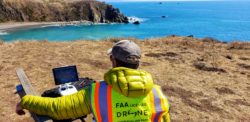
Why We’re Thankful for Kelp Forests

Gray whale and calf in kelp forest in Monterey Bay National Marine Sanctuary. Photo: Douglas Croft
This time of year is perfect for reflecting on the things large and small we are thankful for. One thing we are thankful for all year long is kelp, the largest species of marine algae that creates and supports some of the most productive marine ecosystems in the world. These marine plants can grow as much as 18 inches per day in ideal conditions and can reach lengths upwards of 175 feet! They grow in dense groupings that create incredible underwater forests that extend from the seafloor to the surface. Kelp forests support more diverse populations of plants and animals than any other single ocean community, including coral reefs.
There are countless reasons why we’re thankful for kelp but, here are some of the top ones:
They provide shelter for some of our favorite species. Kelp anchor to the seafloor and grow upwards toward the sunlight. Kelp forests have tiers in the same way rainforests on land do — they have a canopy and multiple layers below. Because they grow so quickly and form dense forests, they provide permanent and temporary habitats for thousands of species of invertebrates, fishes, algae, and marine mammals like whales, sea lions, and dolphins. Some species use kelp forests for spawning and nursery habitats while others hide there temporarily as protection from predators. During storms, kelp weaken currents and waves, allowing birds, marine mammals, and fish to seek refuge while they wait for the weather to pass.
They offer coastline protection. Similar to mangrove forests and coral reefs, kelp forests are natural defenders of our coastlines. They buffer wave action and strong currents that are the result of storm surges and changes in the tides. They also prevent erosion by trapping nearshore sands and preventing them from being swept out to sea. These plants also filter pollutants and debris, which helps ecosystems that support economically important activities like fishing, diving, and other tourism.
They are a source of food. Kelp makes its own food by converting sunlight and organic compounds into sugars, and it stores nutrients in its leaves and stem. In turn, kelp is an important food source for animals like urchins, snails, and fish. The animals that feed on kelp then provide food for larger predatory animals like birds, sharks, and marine mammals. Even when kelp die, they decompose and float at the water’s surface or sink to the seafloor, providing food to scavengers like crabs and worms.
They trap and store carbon dioxide and help combat climate change. Kelp’s rapid growth requires a lot of carbon molecules to use in photosynthesis. It removes carbon dioxide from the environment and stores the carbon molecules in its vegetation throughout its lifespan, and releases oxygen molecules as a byproduct. As the kelp grows, it requires more carbon dioxide to feed itself, pulling more and more carbon dioxide from the environment in the process. The carbon it sequesters does not enter the atmosphere or the ocean, offsetting the effects of human-linked climate change and ocean acidification.
They’re beautiful and rich ecosystems. From otters using stalks of kelp as anchors to help them from drifting out to sea to whales feeding between kelp communities and from sparking fish darting in and out of the kelp leaves to invertebrates marching along the seafloor, kelp forests allow us to see and study some unique animal behaviors and witness rich and healthy ecosystems at work.

Sea otter wrapped in kelp in Monterey Bay National Marine Sanctuary. Photo: Douglas Croft
Kelp forests are important and resilient ecosystems, but they are also incredibly dynamic and sensitive. They can disappear based on changes in oceanographic conditions, an imbalance of predators like sea urchins, irregular climate and seasonal variability, destructive fishing practices that cause physical damage to kelp, or storms that can decimate large kelp forests by ripping the kelp from the seafloor.
Within the National Marine Sanctuary System, four house kelp forests: Channel Islands, Monterey Bay, Greater Farallones, and Olympic Coast. These sanctuaries are home to two kelp species: bull kelp and giant kelp.
To address, prevent, and reverse kelp forest loss and keep these wondrous places healthy and abundant, the National Marine Sanctuary Foundation is working with Greater Farallones Association and Greater Farallones, Monterey Bay, Olympic Coast, and Channel Islands national marine sanctuaries to supports kelp research and conservation. Ongoing projects, including the Greater Farallones Kelp Recovery Program, are focused on removing sea urchin and studying the impacts of these removals. In addition, the Foundation is supporting a mapping project by the Greater Farallones Association to assess kelp canopy within California’s national marine sanctuaries. The project focuses on identifying the extent of kelp canopy loss, improving kelp monitoring and assessment, and determining sites for active recovery and restoration. You can kearn more about the project here. And, get a further look in from Francesca Koe, an ocean advocate, volunteer for Greater Farallones National Marine Sanctuary, and 2019 Ocean Awards Gala honoree, who works on bull kelp research and restoration.

Kelp assessment project underway. Photo: Greater Farallones Association
